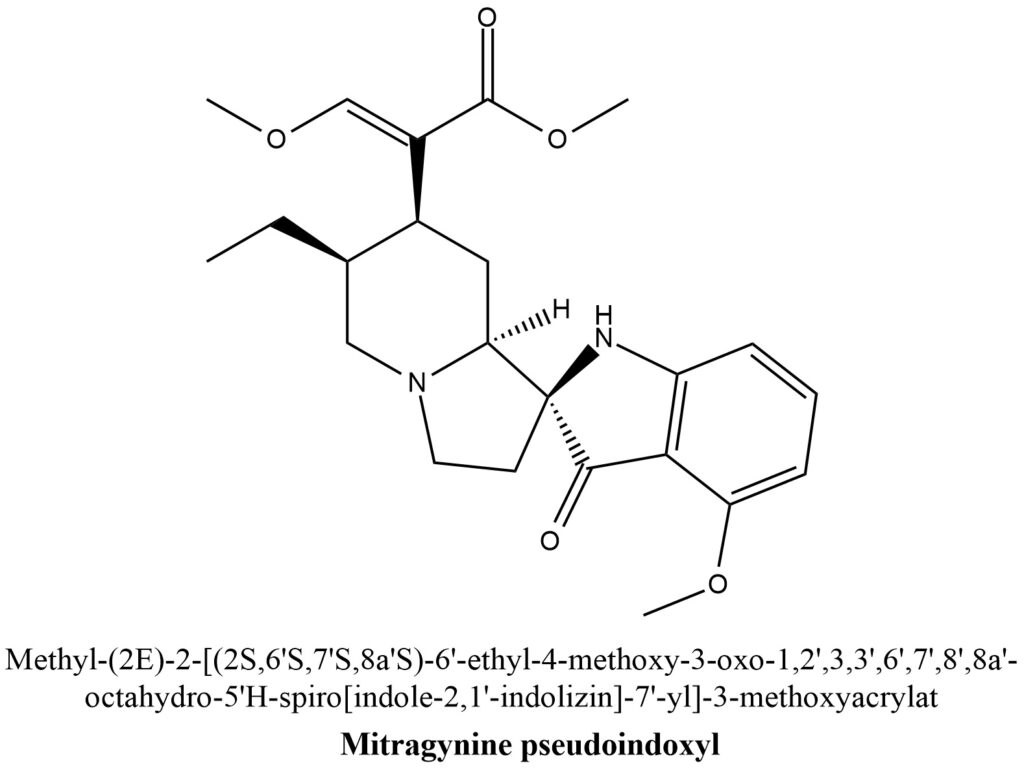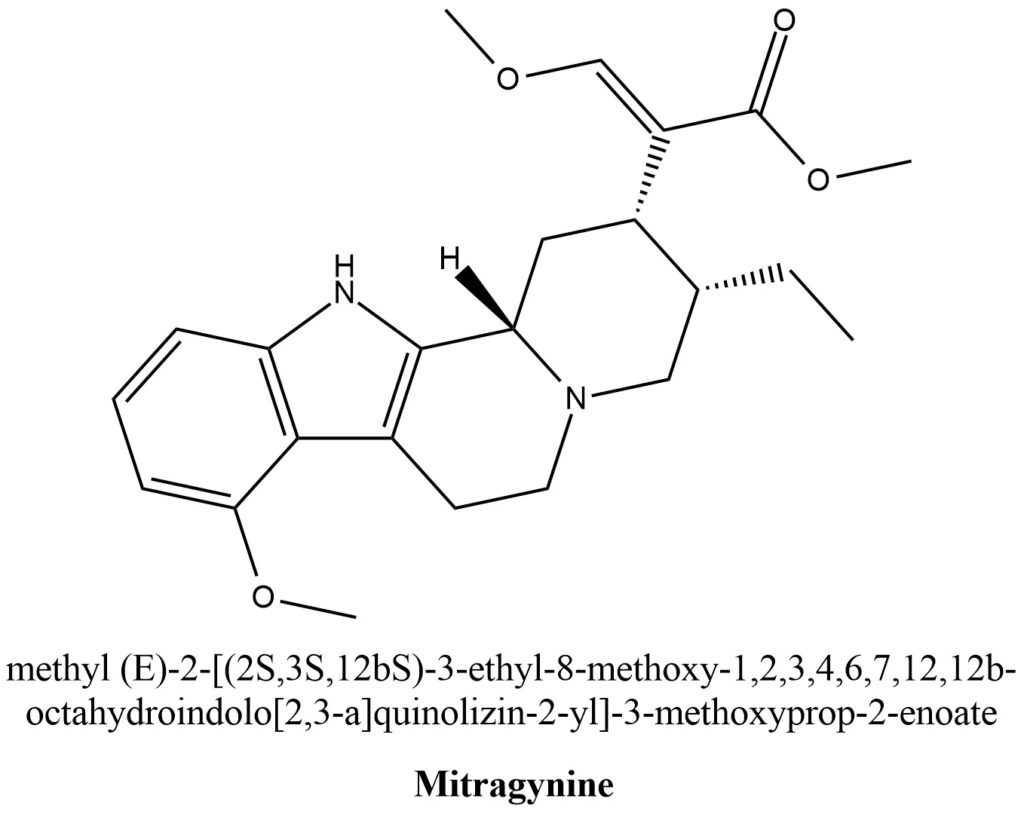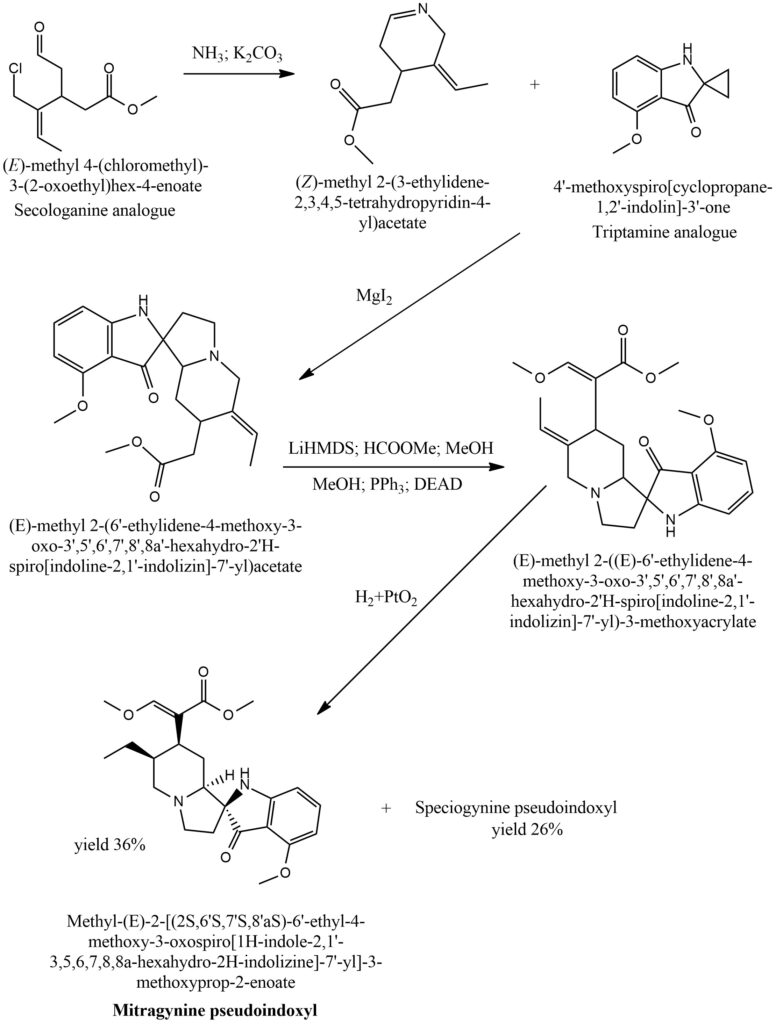Abstract
Mitragynine pseudoindoxyl (MPI) is an alkaloid derivative of Mitragynine, which is, in turn, one of the primary active components found in the Kratom plant (Mitragyna speciosa). Kratom is a tropical tree native to Southeast Asia, and its leaves are often used in traditional medicine and as a psychoactive substance. This article provides an overview of Mitragynine pseudoindoxyl, encompassing its general characteristics, physicochemical properties, recreational pharmacology, effects and symptoms associated with Mitragynine pseudoindoxyl use, street names, pricing and approximate dosage, legal status, synthesis methods for Mitragynine pseudoindoxyl, concluding remarks, and a bibliography.
Kratom Extraction Redux: Preparation of “Crystal Kratom” in Extreme Detail (2/2) (Reupload)
General Information About Mitragynine pseudoindoxyl [1-3]
IUPAC Names of Mitragynine pseudoindoxyl: Methyl-(2E)-2-[(2S,6’S,7’S,8a’S)-6′-ethyl-4-methoxy-3-oxo-1,2′,3,3′,6′,7′,8′,8a’-octahydro-5’H-spiro[indole-2,1′-indolizin]-7′-yl]-3-methoxyacrylat
and
Methyl-(E)-2-[(2S,6’S,7’S,8’aS)-6′-ethyl-4-methoxy-3-oxospiro[1H-indole-2,1′-3,5,6,7,8,8a-hexahydro-2H-indolizine]-7′-yl]-3-methoxyprop-2-enoate
CAS numbers are 2035457-43-1
Physico-Chemical Properties of Mitragynine pseudoindoxyl [1-3]
Molecular Formula C23H30N2O5
Molar Weight 414.5 g/mol
Boiling point 580.9±50.0 °C at 760 mmHg
Structural formula of Mitragynine pseudoindoxyl present on Figure 1.

Figure 1. Structure of Mitragynine pseudoindoxyl
Structure of Mitragyninepresent on Figure 2.

Figure 2. Structure of Mitragynine
General Information of Mitragynine pseudoindoxyl in Recreational Use and Pharmacology [4-7]
Mitragynine pseudoindoxyl is an alkaloid derived from mitragynine, the primary indole alkaloid found in the leaves of the traditional Thai folk medicine plant Mitragyna speciosa Korth, commonly known as kratom in the Thai language.
Mitragynine pseudoindoxyl acts as a μ opioid receptor agonist and a m opioid receptor antagonist. It functions as a G protein-biased agonist at μ opioid receptors, offering a more favorable side effect profile compared to conventional opioids. Cryo-electron microscopy (Cryo-EM) structures of the μOR-Gi1 complex, with mitragynine pseudoindoxyl and lofentanil (one of the most potent opioids), reveal distinct binding subpockets for these two ligands. Molecular dynamics simulations further highlight differences in the binding site, which promote unique active-state conformations on the intracellular side of the receptor where G proteins and β-arrestins bind. Importantly, studies have demonstrated that oxidative metabolism can convert mitragynine, the primary alkaloid in kratom, into mitragynine pseudoindoxyl through a two-step process, likely influencing kratom’s complex pharmacological effects.
Mitragynine pseudoindoxyl exhibits significant analgesic activity, surpassing mitragynine’s potency by nearly tenfold when administered orally or intraperitoneally in animal models.
Despite these insights, numerous aspects of kratom’s pharmacology remain underexplored, though new research findings are gradually emerging [5].
Effects and symptoms of Mitragynine pseudoindoxyl Use
Impact of Mitragynine Pseudoindoxyl – Figure 3.
![Figure 3. Mitragynine pseudoindoxyl effect [6]](https://safrole.com/wp-content/uploads/fig-3-42.jpg)
Figure 3. Mitragynine pseudoindoxyl effect [6]
Exploring Mitragynine Pseudoindoxyl: Unveiling Its Opioid Analgesic Benefits, Free from Conditioned Effects, and with a Remarkably Improved Side Effect Profile. It Disentangles Antinociception from Traditional Opioid Downsides like Tolerance, Dependence, and Conditioned Preference. Additionally, Mitragynine Pseudoindoxyl Exhibits Reduced Likelihood of Inducing Respiratory Depression and Constipation in Contrast to the Conventional Opioid, Morphine.
In 1975, a study involving 30 Thai kratom users, primarily older married men with over 5 years of usage, was conducted. Ninety percent of these individuals chewed the fresh leaves or consumed them as a powder, often adding salt to prevent constipation. The leaves were chewed three to ten times a day, leading to stimulant effects within 5-10 minutes. Many users reported becoming addicted as they sought to enhance their productivity, and the drug was also noted to have calming effects on the mind. Common side effects included dry mouth, frequent urination, constipation, darkened feces, loss of appetite, and weight loss. Withdrawal symptoms encompassed aggression, tearfulness, runny nose, musculoskeletal aches, and involuntary movements. The kratom habit was observed to be culturally bound to Thailand, primarily a ritualistic practice in rural areas, with the society accepting male addicts who contributed to their families’ support but not female addicts.
Street Names, Prices and Approximate Dosage [4-7]
In typical concentrations of mitragynine found in dry leaf powder available in the US (approximately 1%), such exposure would necessitate the consumption of over 250 grams of plant material—an unlikely scenario, considering that most users report ingesting less than 10 grams per dose. Nevertheless, given the occurrence of reported deaths linked to kratom use with unclear causes, caution in the human utilization of kratom is advisable until further research becomes available.
Consistent with previous in vitro findings, Mitragynine Pseudoindoxyl (MP) exhibited binding potency 200 times greater and acted as an agonist 120 times more effectively than mitragynine [5]. A potent kratom brew (exceeding 10 grams of dried leaves per serving) produces pronounced analgesic and sedative effects. Overdosing may lead to blurred vision, nausea, and potential vomiting. A milder brew (approximately 1-3 grams) possesses slightly stimulating properties reminiscent of caffeine, devoid of adverse effects like accelerated heart rate, and can alleviate mild pain, enhance concentration across various activities, and boost physical endurance.
Kratom, derived from the leaves of the Southeast Asian Mitragyna speciosa plant, has seen increased usage in the United States due to its stimulant and opioid-like properties. It contains numerous active alkaloids, with mitragynine being the most prominent. However, clinical pharmacological research and toxicological data remain limited, posing challenges in forensic analysis and understanding kratom’s potential role in fatalities.
Despite claims by vocal proponents and vendors asserting kratom’s safety, an expanding body of evidence suggests that kratom use can lead to significant adverse events, including fatalities [7]. Deciphering the forensic implications of mitragynine remains complex. Kratom has been implicated in a rising number of overdoses and deaths, but its exact contribution is challenging to determine due to numerous confounding factors, including limited toxicological testing and frequent co-occurrence with other substances of abuse.
Legal Status [1]
In 2016, the United States Drug Enforcement Administration (DEA) issued a preliminary notice of intent to classify mitragynine and its oxidized counterpart, 7OH, as Schedule I substances under the Controlled Substances Act (CSA). However, following public outcry and extensive coverage in national media, the notice was rescinded just two months later.
The legal status of kratom and its components varies from one country to another and can even differ within individual jurisdictions. Some countries and states recognize kratom and its alkaloids as legal substances, while others prohibit their use. Certain regions may impose restrictions or regulations on their sale and consumption.
Synthesis of Mitragynine pseudoindoxyl [8]
The comprehensive synthesis details are provided in Article [8], with the overall synthesis scheme illustrated in Figure 4.

Hamilton Morris talks kratom prohibition, botany, and pharmacology
Conclusion
Mitragynine pseudoindoxyl (MPI) is an alkaloid derivative of Mitragynine, which, in turn, constitutes one of the primary active compounds present in the Kratom plant (Mitragyna speciosa). Kratom has been linked to a rising number of overdoses and fatalities, yet determining its precise contribution remains challenging due to numerous confounding factors, including limited toxicological research and frequent co-administration with other substances of abuse.
Bibliography
- https://en.wikipedia.org/wiki/Mitragynine_pseudoindoxyl
- https://pubchem.ncbi.nlm.nih.gov/compound/44301701
- https://www.chemspider.com/Chemical-Structure.23152339.html
- Leonardo T. Yamamoto, Syunji Horie Opioid receptor agonistic characteristics of mitragynine pseudoindoxyl in comparison with mitragynine derived from Thai medicinal plant Mitragyna speciosa. General Pharmacology, 1999, 33, pp. 73–81. https://doi.org/10.1016/S0306-3623(98)00265-1 https://www.sciencedirect.com/science/article/abs/pii/S0306362398002651
- Soumen Chakraborty, Rajendra Uprety etc. Oxidative Metabolism as a Modulator of Kratom’s Biological Actions. J. Med. Chem., 2021, 64, 22, pp. 16553–16572. https://doi.org/10.1021/acs.jmedchem.1c01111 https://pubs.acs.org/doi/abs/10.1021/acs.jmedchem.1c01111
- András Váradi, Gina F. Marrone etc. Mitragynine/Corynantheidine Pseudoindoxyls As Opioid Analgesics with Mu Agonism and Delta Antagonism, Which Do Not Recruit β-Arrestin-2. J Med Chem., 2016, 59, 18, pp. 8381–8397. doi: 10.1021/acs.jmedchem.6b00748 https://www.ncbi.nlm.nih.gov/pmc/articles/PMC5344672/?fbclid=IwAR2_Y3SvMCFYeAd-8-rNEMQtCA0-ThPg7vkk3Ge6J-gVq9GlfmPA203GI8M
- Donna Papsun, William Schroeder II etc. Forensic Implications of Kratom: Kratom Toxicity, Correlation with Mitragynine Concentrations, and Polypharmacy. Current Addiction Reports, 2023, vol. 10, pp. 272–281. https://doi.org/10.1007/s40429-023-00477-4 https://link.springer.com/article/10.1007/s40429-023-00477-4
- Péter Angyal, Kristóf Hegedüs etc. Total Synthesis and Structural Plasticity of Kratom Pseudoindoxyl Metabolites. Angew. Chem. Int. Ed., 2023, 62, 35. doi.org/10.1002/anie.202303700 https://onlinelibrary.wiley.com/doi/full/10.1002/anie.202303700


